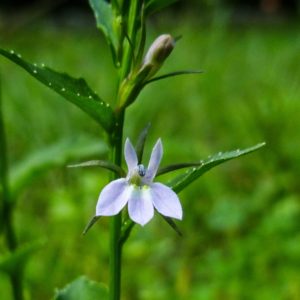
Lobelia
Det är svårt att förstå beroende om du aldrig har upplevt det själv. – Ken Hensley
![]()
Lobelia kallas även “Indiantobak” och har används länge i historien vid andningsbesvär, asthma, bronkit, lunginflammation och hosta. Den amerikanska ursprungsbefolkningen rökte lobelia för att lindra asthma. På 1800-talet började man ordinera lobelia som kräkmedel för att driva ut gifter ur kroppen. Det gjorde att man började kalla lobelia för “pukeweed”. I högre dos framkallar lobelia kräkning och det ska man veta om man är intresserad av att använda denna ört.
![]()
Lobelia impacts neurotransmitter activity in a way that is similar to nicotine. The active ingredient, Lobeline, is a both a nicotine agonist and antagonist derived from an Indian plant “lobelia inflata.” Here’s what that means:
The brain has neurotransmitter receptor cells that have been labeled ‘nicotinic’ receptors because they are stimulated by nicotine. Lobeline acts on these cells as an ‘agonist,’ which means that it binds to these cells and stimulates them in a similar way to nicotine. (The effects are not as strong as nicotine, however.) Because the drug is in effect ‘parked’ at the receptor sites on these cells, it also partially blocks nicotine from activating them, thereby reducing the effect of nicotine in the brain from smoking, and helping to reduce the ‘reward’ associated with smoking.
Interestingly, unlike nicotine, which is highly addictive, lobeline does not appear to be addictive. This may be because of its structural differences from nicotine, and the different ways that it affects dopamine storage and release. (Dopamine is another a neurotransmitter – one that is implicated in addictive patterns of behavior.)
Rather than stimulating the release of dopamine in the normal way (from the presynaptic terminal), lobeline appears to induce the metabolism of dopamine intraneuronally as well as inhibit dopamine re-uptake. The result of this is that rather than getting a ‘dose’ of rewarding dopamine immediately connected to the behavior of smoking (or of taking lobeline), the dopamine effect is more diffuse. So you still get the pleasant dopamine effect, but because it is not strongly associated with the behavior, it does not induce addictive behaviors, and in fact partially blocks the addictive effect of nicotine intake.
Dwoskin LP, Crooks PA., (2002) A novel mechanism of action and potential use for lobeline as a treatment for psychostimulant abuse. Biochemical Pharmacology. Jan 15;63(2):89-98.
![]()
Jag har gjort ett spagyriskt elixir (så kallar jag mina blandningar som innehåller flera spagyriska tinkturer) som stöttar de som vill sluta röka eller snusa. Hittills har denna blandning hjälpt ett dussin att sluta, mig själv inkluderad!
Jag rekomenderar rökare och snusare som vill sluta vara det detta elixir framför den rena spagyriska lobeliatinkturen för mitt sluta röka support elixir innehåller även lugnande och adaptogena örter som hjälper den som slutar att hantera stress.
jag vill dela med mig av 2 tips till den som vill sluta att röka att använda i kombination med elixiret:
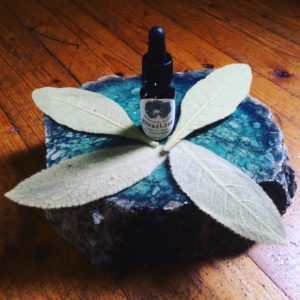
Kungsljus
Transformation av det som förhärdats så det blir mjukt igen.
![]()
Kungsljus kan användas vid besvär i luftvägarna; lungorna, halsen och bronkerna. Bladen är otroligt mjuka och lite ludna. Kungsljusets lära handlar om att förvandla det som blivit hårt så att det blir mjukt. Denna verkan sker på de fysiska, mentala och själsliga planen samtidigt. Fysiskt så mjukgör och återfuktar kungsljuset irriterade, uttorkade och inflammerade slemhinnor, särskillt i lungorna, men även i de fuktiga mellanrummen mellan ryggradens kotor där det är meningen att det ska vara ett flöde. Kungsljusstjälkarna liknar ju dessutom en ryggrad. Naturen kommunicerar med oss via signaturläran, signs of nature, naturens teckenspråk.
![]()
Kungsljusets stöd i att transformera det hårda till att bli mjukt fungerar även på mental nivå. Kungsljus är bra för personer som är hårda mot sig själva och kritiska i allmänhet. Kungsljusstjälkar doppades i vax av druiderna och användes som facklor vid ceremonier. Fackel-signaturen handlar om att Kungsljuset lyser upp ens livsväg, ger fokus och upplysning. Människor som känner sig vilsna känner sig ofta ur led och famlandes i mörkret, det kan skapa spänningstillstånd och en känsla av övergivenhet. Kungsljus är bra för de som går på sparlåga och som behöver lite extra ryggrad.
![]()
Matthew Wood skriver att Kungsljus är bra för de som tänker för mycket så att det stockar sig i sinnet, eller för de som blir spända efter komplicerade projekt. Han skriver att kungsljuset ger dessa personer en känsla av att sinnet öppnades upp som av en vårvind.
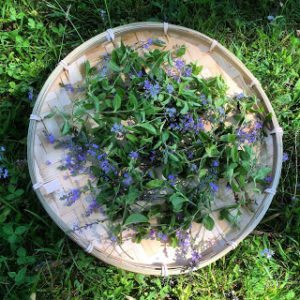
Ärenpris
“I am most glad I loved thee—think of all
The suns that go to make one speedwell blue! – Oscar Wilde
![]()
Ärenpris var högt prisad som hörs på namnet. Sedan rommarrikets dagar ansågs den påskynda läkandeprocesser. För ungefär 100 år sedan föll den lite i glömska och används inte så mycket längre.
Den används främst för andningsproblem, hosta. Den hjälper en att driva ut slem ur luftvägarna. Ärenpris verkar även helande för magsår och återskapar slemhinnorna i magen. Den var känd för att hela lungorna och det pågår ny forskning inom detta just nu.
![]()
Maria Treben rekomenderar Ärenpris för nerverna och utmattningssymtom. Jag anser att att Ärenpris är grundnade , jordande, samtidigt som den lyfter och ger lätthet. Det är som att chakrana kalibreras och man står stadigt mellan himmel och jord.
Ärenpris innehåller ämnet scutellarin, som fått namnet av vår lugnande vän Frossörten, som heter Scutellaria Galericulata på latin.
Jag har både Frossört och Ärenpris i mitt Sluta Röka Support-elixir.
![]()
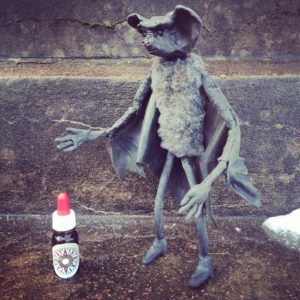
Resenärens Elixir
“All journeys have secret destinations of which the traveler is unaware.” – Martin Buber
Spagyriskt elixir för resenären.
Detta ayurvediska elixir stödjer kroppens förmåga till flexibilitet och för att fysiskt och mentalt fungera optimalt under resan. Det främjar sunda sömnmönster, hjälper till att eliminera gifter som samlas pga oregelbundna mat och sovrutiner, stödjer matsmältningen, immunförsvaret, luftvägarna och det centrala nervsystemet samt minskar effekten av jet lag. Detta elixir hjälper resenären att uppskatta resandet lika mycket som resans destination.
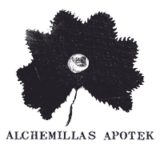
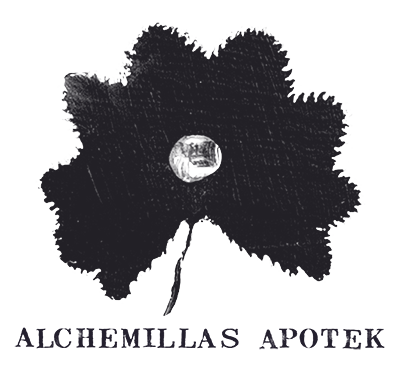

 English
English Svenska
Svenska